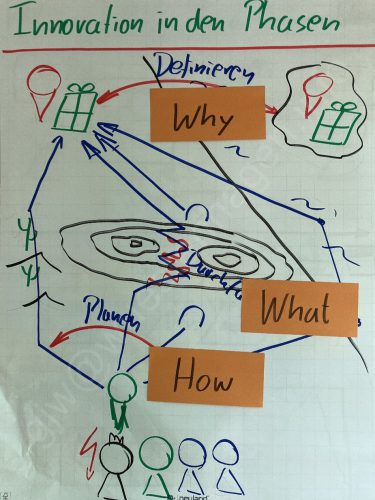Projektmanagement@GJW
DE
Innovation in den Projektphasen
Warum: Die zentralen Stellen im Projektmanagement für die höhe des Innovationsgrades kennen und bewusst nutzen.
.
Wie: Im >Definieren< das Potential für den größten Innovationsgrad erkennen und gegebenenfalls nutzen, im >Planen< das Potential für den zweitgrößten Innovationsgrad erkennen und gegebenenfalls nutzen, im >Durchführen< das zum Teil begrenzte Potential für den Innovationsgrad erkennen.
.
Was: In den drei Phasen >Definieren<, >Planen< und >Durchführen< werden je nach Herangehen die Weichen für den Innovationsgrad im Projekt unterschiedlich gestellt. Im >Definieren< finden grundlegende Weichenstellungen statt durch das genaue Verstehen des Kunden-Bedarfs (in der Grafik: Will der Kunde auf die Insel oder das Festland). Voreiliges Verstehen grenzt den Lösungsraum sehr stark ein. Im >Planen< findet die nächste Weichenstellung durch die Wahl des Lösungskonzeptes statt (in der Grafik: Konzept über die See, über den Pass, unter dem Berg oder durch die Wüste). Das Zurückgreifen auf das immer gleiche Lösungskonzept grenzt den Lösungsraum weiter ein. Im >Durchführen< schließlich werden die Weichen für feine Verbesserungen des gewählten Konzeptes gestellt. Hier ist der Einfluss auf den Innovationsgrad eher gering.
Im >Definieren< kann das Ziel/der Liefergegenstand SMART festgelegt werden. Aussagen über Zeit und Kosten sind hier noch nicht möglich, da erst im >Planen< das Konzept zum Erreichen des Ziels/des Liefergegenstand festgelegt wird.
Bezogen auf die Grafik bedeutet dies: Im >Definieren< kann ich vereinbaren, dass das Ziel/der Liefergegenstand jenseits des Berges liegt. Erst im >Planen< wird das Konzept entwickelt, ob dies durch einen Weg über den Berg, durch den Berg, am Berg vorbei über das Wasser oder am Berg vorbei durch die Ebene erfolgt. Ist dies entschieden, können Aussagen über die benötigten Ressourcen (Schiffe und Seeleute oder Tunnelmaschinen und Mineure etc.) nach Menge und Zeit getroffen werden.
EN
Innovation in the project phases
Why: Recognize and consciously utilize the central points in project management for the level of innovation.
.
How: In >Define<, recognize and potentially utilize the potential for the highest level of innovation, in >Plan< recognize and potentially utilize the potential for the second-highest level of innovation, in >Execute< recognize the partially limited potential for innovation.
.
What: In the three phases—>Define<, >Plan<, and >Execute< — different decisions are made regarding the level of innovation in the project, depending on the approach. In >Define<, fundamental decisions are made by precisely understanding the customer’s needs (in the graphic: Does the customer want to go to the island or the mainland). Premature understanding severely restricts the solution space. In >Plan<, the next decision is made by choosing the solution concept (in the graphic: Concept over the sea, over the pass, under the mountain, or through the desert). Repeatedly resorting to the same solution concept further narrows down the solution space. Finally, in >Execute<, decisions are made for fine-tuning the chosen concept. Here, the influence on the level of innovation is relatively low.
In >Define<, the goal/deliverable can be set SMART. Statements about time and cost are not yet possible here because it is only in >Plan< that the concept for achieving the goal/deliverable is determined.
In terms of the graphic, this means: In >Define<, I can agree that the goal/deliverable lies beyond the mountain. Only in >Plan< is the concept developed, whether this is achieved by a path over the mountain, through the mountain, past the mountain over the water, or past the mountain through the plain. Once this is decided, statements can be made about the required resources (ships and sailors or tunneling machines and miners, etc.) in terms of quantity and time.
Geplante/Erforderliche Verbesserungen
tbd
